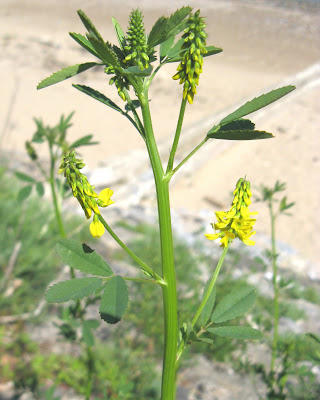
This blog may help people explore some of the 'hidden' issues involved in certain media treatments of environmental and scientific issues. Using personal digital images, it's also intended to emphasise seasonal (and other) changes in natural history of the Swansea (South Wales) area. The material should help participants in field-based modules and people generally interested in the natural world. The views are wholly those of the author.
Monday 28 June 2010
Seeing the Changes 307
Along the Clyne Valley cycle track, there was lots of Enchanter's nightshade (Circaea lutetiana). Nearer to Loughor, Meadowsweet (Filipendula ulmaria) was in bloom by the roadside. At Westcross, noted the semi-parasitic Common broomrape (Orobanche minor), Crow garlic (Allium vineale), the almost-emerged Hemp agrimony (Eupatorium cannabinum) and the Hogweed (Heracleum sphondylium). At Blackpill, the hips of Burnet rose (Rosa pimpinellifolia) were ripening.
Saturday 26 June 2010
Seeing the Changes 306
In Bynea, Garden privet (Ligustrum ovalifolium) was in flower. Cinnabar moth (Tyria jacobaeae) larvae had invaded the Ragwort. In Loughor, there were masses of purple-spiked Rosebay willowherb (Epilobium angustifolium) along with Large-flowered hemp nettle (Galeopsis speciosa). In Oxwich, there was a Plume moth (Agdistis bennetii) and much activity from Orthoptera. Many nymphs of Great green bush crickets (Tettigonia virridissima) along with the Common field grasshopper (Chorthippus brunneus). In Gowerton, Ragged robin (Lychnis flos-cuculi) had presumably been in flower for a while and, along Clyne Valley, Himalayan balsam (Impatiens glandulifera) reminded me of Sikkim.
Thursday 24 June 2010
Seeing the Changes 305
In Loughor, Tutsan (Hypericum androsaemum) was in bloom. In Swansea, Fat hen (Chenopodium album) was coming into flower. Lords and Ladies (Arum maculatum) was in berry and Great mullein plants were being consumed by the voracious larvae of the Mullein moth (Shargacucullia verbasci).
Wednesday 23 June 2010
The Twit is Twittering
I have finally relented and have grabbed the only Twitter address that is still available (@fredbrain) as pbrain had already gone.
Tuesday 22 June 2010
Bumbling Along
There is growing concern about a shortage of bumble-bees in the UK (http://www.guardian.co.uk/environment/2010/jun/22/chemicals-bees-decline-major-study) and a major study suggests that a 'cocktail' of chemicals are messing with their brains. A reduction of these important pollinating insects is of great economic importance to fruit and crop production. Most of the chemicals result from agricultural practices. It consequently seems a bit premature (as has been advocated) to start hacking at the legislation ('red tape') surrounding farming activities (http://www.guardian.co.uk/environment/2010/jun/21/green-campaigners-farm-review-nfu). A batch of Short-haired bumble-bees reintroduced to the country from New Zealand (where they were transported) died almost as soon as they were released!
Monday 21 June 2010
Seeing the Changes 304
At Westcross, Golden samphire (Inula crithmoides), Field bindweed (Convolvulus arvensis), Lucerne (Medicago sativa) and Sea mayweed (Tripleurospermum maritimum).
Sunday 20 June 2010
Seeing the Changes 303
At Oxwich, Wild thyme (Thymus serpyllum), Eyebright (Euphrasia officinalis), Sea holly (Eryngium maritimum), Wild privet (Ligustrum vulgare) and Pyramidal orchid (Anacamptis pyramidalis) were in flower. A Silver 'Y' moth ( Autographa gamma) and an Emperor dragonfly (Anax imperator) flitted about.
Saturday 19 June 2010
Seeing the Changes 302
A Bloodvein moth (Timandra griseta) visited in Loughor. In that location, Great willowherb (Epilobium hirsutum) and Hairy St John's wort (Hypericum hirsutum) were in bloom. In Bynea, Black knapweed (Centaurea nigra), Canadian fleabane (Conyza canadensis), Square-stalked St John's wort (Hypericum tetrapterum), Dwarf mallow (Malva neglecta) and Pale toadflax (Linaria repens) were in flower. In Penclacwydd, Creeping thistle (Cirsium arvense), Woolly thistle (Cirsium eriophorum) and Purple loosestrife (Lythrum salicaria) were out. I have seen Small tortoiseshells (Aglais urticae) earlier in the year but there seemed to be a lot of activity by this butterfly over the whole distance today.
Thursday 17 June 2010
Mumble it Softly
+with+chick+Mumbles+pier.jpg)
The proposed £39m upgrade of Mumbles Pier is, in one sense, welcome (http://news.bbc.co.uk/1/hi/wales/south_west_wales/10332703.stm) with a repairing of the structure and the building of new flats etc. It is a little sad, however, that the Kittiwake (Rissa tridactyla) colony that currently nest on the closed area of the pier will be displaced. I appreciate that these gulls are not rare but it was one of the easiest locations to view these birds at the time of egg laying and chick development.
Wednesday 16 June 2010
Seeing the Changes 301








 Hot weather again in Swansea. Lady's bedstraw (Galium verum), Rest-harrow (Ononis repens) and Large-flowered evening primrose (Oenothera erythrosepala) were blooming in Blackpill. In Westcross, they were joined by Common sea-lavender (Limonium vulgare), Knotgrass (Polygonum aviculare), Rock samphire (Crithmum maritimum), Brookweed (Samolus valerandi) and Ribbed melilot (Melilotus officinalis). In Loughor, greeted by fresh butterfly eggs on Nasturtium.
Hot weather again in Swansea. Lady's bedstraw (Galium verum), Rest-harrow (Ononis repens) and Large-flowered evening primrose (Oenothera erythrosepala) were blooming in Blackpill. In Westcross, they were joined by Common sea-lavender (Limonium vulgare), Knotgrass (Polygonum aviculare), Rock samphire (Crithmum maritimum), Brookweed (Samolus valerandi) and Ribbed melilot (Melilotus officinalis). In Loughor, greeted by fresh butterfly eggs on Nasturtium.
Subscribe to:
Posts (Atom)
What's In a Critter's Name? 20. Otter
The word 'otter' derives from the Old English word 'otor' or 'oter' This, and similar words, stem from the Proto-In...

-
The UK government continue their quest to turn England's rivers back into sewers. They first facilitated the privatised water companies...
-
Garden plants in France, The Netherlands, The UK and Sikkim (NE India).



+Blackpill.jpg)



+cental+Swansea.jpg)










+Blackpill.JPG)


++on+Meadow+marigold+North+Gower+South+Wales.jpg)
+Mubles.jpg)










+adult+on+thistle+NWCW.jpg)













